Early history of submarines and the first
submersibles
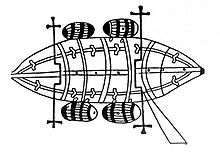
Submarine by Guido da Vigevano
(1280–1349). |

Submarine by Roberto Valturio,
in De Re Militari, 1472. |

A 16th-century Islamic painting
depicting Alexander the Great being lowered in a glass submersible. |
The concept of an underwater boat has roots deep
in antiquity. Although there are images of men using hollow sticks to breathe
underwater for hunting at the temples at Thebes, the first known military
use is of divers being used to clear obstructions during the siege of Syracuse
(about 413 BC), according to the History of the Peloponnesian War. At the
siege of Tyre in 332 BC divers were again used by Alexander the Great,
according to Aristotle. Later legends from Alexandria, Egypt, in the 12th
century AD suggested that he had used a primitive submersible for reconnaissance
missions. This seems to have been a form of diving bell, and was depicted
in a 16th-century Islamic painting. Abraham ibn Ezra (about 1150) interprets
Noah's Ark as being a vessel that floated for 40 days on water, after which
it floated to the surface.
After various plans for submersibles or submarines
during the Middle-Ages, the Englishman William Bourne designed a prototype
submarine in 1578, although these ideas never got beyond the planning stage.
However, the first submersible proper to be actually built in modern times
was constructed in 1605 by Magnus Pegelius but this became buried in mud.
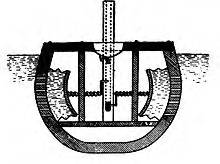
Submarine by William Bourne, in
Inventions or devices, 1578. |

Submarine of Cornelius Jacobszoon
Drebbel, 1620 and 1624. |
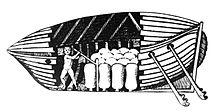
Submarine by Giovanni Alfonso Borelli,
in De Motu Animalium, 1680. |
The first successful submarine was built in 1620
by Cornelius Jacobszoon Drebbel, a Dutchman in the service of James I;
it may have been based on Bourne's design. It was propelled by oars. The
precise nature of the submarine type is a matter of some controversy; some
claim that it was merely a bell towed by a boat. Two improved types were
tested in the Thames between 1620 and 1624.
Though the first submersible vehicles were tools
for exploring under water, it did not take long for inventors to recognize
their military potential. The strategic advantages of submarines were set
out by Bishop John Wilkins of Chester in Mathematicall Magick in 1648:
| 1. |
Tis private: a man may thus go to any coast in
the world invisibly, without discovery or prevented in his journey. |
| 2. |
Tis safe, from the uncertainty of Tides, and
the violence of Tempests, which do never move the sea above five or six
paces deep. From Pirates and Robbers which do so infest other voyages;
from ice and great frost, which do so much endanger the passages towards
the Poles. |
| 3. |
It may be of great advantages against a Navy
of enemies, who by this may be undermined in the water and blown up. |
| 4. |
It may be of special use for the relief
of any place besieged by water, to convey unto them invisible supplies;
and so likewise for the surprisal of any place that is accessible by water. |
| 5. |
It may be of unspeakable benefit for submarine
experiments. |
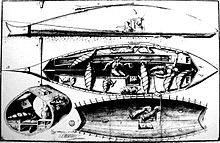
Fish-like submarine, by Jean-Baptiste
Chabert, 1689. |
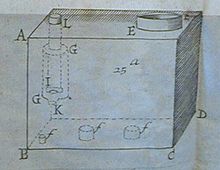
Denis Papin's submarine, first
design, 1690. |
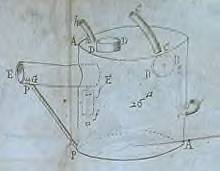
Denis Papin's submarine, second
design, 1690. |
Between 1690 and 1692, the French physicist Denis
Papin, designed and built two submarines. A detailed description of his
work is given in the book named "recueil de diverses pièces" (1695).
The first design (1690) was a strong and heavy metallic square box, equipped
with an efficient pump. Once the hull is in the water, and weights loaded
on board, the "man hole" is bolted, and it is time to pump air to raise
the inner pressure. When the barometer shows that air pressure inside is
high enough, holes F on the floor can be opened, to let the operator intake
the necessary amount of water. This first machine was destroyed by accident,
before it was tested in water.
Denis Papin's submarine, second design, 1690.
The second design was built in 1692 : the hull
has now an oval shape, naturally resistant to the outside pressure : outside
air goes in and out freely in the hull, thanks to a centrifugal air pump.
After having loaded the hull with enough solid weight, the top of the hull
nearly match the water surface, and the "man hole" has to be bolted. A
water pump allows then to take in or out a volume of water, to control
buoyancy. According to some sources, a spy of Leibniz, called Haes related
that Papin and another man, met success in experimenting this second design,
on the river Lahn.
By the 17th century the Ukrainian Cossacks were
using a riverboat called the chaika (gull) that was used underwater for
reconnaissance and infiltration missions. This seems to have been closer
to (and may have been developed from) Aristotle's description of the submersible
used by Alexander the Great. The Chaika could be easily capsized and submerged
so that the crew was able to breathe underneath (like in a modern diving
bell) and propel the vessel by walking on the bottom of river. Special
plummets (for submerging) and pipes for additional breathing were used.
By 1727, 14 types of submarine had been patented
in England. In 1749 the Gentlemen's Magazine described a proposal made
by Giovanni Borelli in 1680 for a boat with goatskins in the hull, each
being connected to an opening. The boat would have been submerged by letting
water into the goatskins and surfaced by forcing water out by a twisting
rod. This seems to be the first approach to the modern ballast tank.
The first military submarines
The first military submarine was Turtle in 1776,
a hand-powered egg-shaped device designed by the American David Bushnell,
to accommodate a single man. It was the first verified submarine capable
of independent underwater operation and movement, and the first to use
screws for propulsion. During the American Revolutionary War, Turtle (operated
by Sgt. Ezra Lee, Continental Army) tried and failed to sink a British
warship, HMS Eagle (flagship of the blockaders) in New York harbor on September
7, 1776. There is no record of any attack in the ships' logs.
In 1800, France built a human-powered submarine
designed by Robert Fulton, the Nautilus. It also had a sail for use on
the surface and so was the first known use of dual propulsion on a submarine.
It proved capable of using mines to destroy two warships during demonstrations.
The French eventually gave up with the experiment in 1804, as did the British
when they later tried the submarine.
During the War of 1812, in 1814 Silas Halsey lost
his life while using a submarine in an unsuccessful attack on a British
warship stationed in New London harbor.
In 1834 a Russian naval designer Karl Shilder
built and tested an all-metal submarine in Saint Petersburg. His submarine
was equipped by 6 Congreve rockets.
In 1851, a Bavarian artillery corporal, Wilhelm
Bauer, took a submarine designed by him called the Brandtaucher (fire-diver)
to sea in Kiel Harbour. This submarine was built by August Howaldt and
powered by a treadwheel. It sank but the crew of 3 managed to escape. The
submarine was raised in 1887 and is on display in a museum in Dresden.
Submarines in the American Civil War
During the American Civil War, the Union was the
first to field a submarine. The French-designed Alligator was the first
U.S. Navy sub and the first to feature compressed air (for air supply)
and an air filtration system. It was the first submarine to carry a diver
lock, which allowed a diver to plant electrically detonated mines on enemy
ships. Initially hand-powered by oars, it was converted after 6 months
to a screw propeller powered by a hand crank. With a crew of 20, it was
larger than Confederate submarines. Alligator was 47 feet (14.3 m) long
and about 4 feet (1.2 m) in diameter. It was lost in a storm off Cape Hatteras
on April 1, 1863 while uncrewed and under tow to its first combat deployment
at Charleston.
The Intelligent Whale was built by Oliver Halstead
and tested by the U.S. Navy after the American Civil War and caused the
deaths of 39 men during trials.
The Confederate States of America fielded several
human-powered submarines, including CSS H. L. Hunley (named for its designer
and chief financier, Horace Lawson Hunley). The first Confederate submarine
was the 30-foot-long (9.1 m) Pioneer, which sank a target schooner using
a towed mine during tests on Lake Pontchartrain but it was not used in
combat. It was scuttled after New Orleans was captured and in 1868 was
sold for scrap; the similar Bayou St. John Confederate Submarine is preserved
in the Louisiana State Museum. CSS Hunley was intended for attacking Union
ships that were blockading Confederate seaports. The submarine had a long
pole with an explosive charge in the bow, called a spar torpedo. The sub
had to approach an enemy vessel, attach the explosive, move away, and then
detonate it. It was extremely hazardous to operate, and had no air supply
other than what was contained inside the main compartment. On two occasions,
the sub sank; on the first occasion half the crew died, and on the second,
the entire eight-man crew (including Hunley himself) drowned. On February
17, 1864, Hunley sank USS Housatonic off the Charleston Harbor, the first
time a submarine successfully sank another ship, though it sank in the
same engagement shortly after signaling its success. Submarines did not
have a major impact on the outcome of the war, but did portend their coming
importance to naval warfare and increased interest in their use in naval
warfare.
Early submarines in Latin America
The Submarino Hipopótamo was the first
submarine in South America built and tested in Ecuador on September 18,
1837. It was designed by Jose Rodriguez Lavandera, who successfully crossed
the Guayas River in Guayaquil accompanied by Jose Quevedo. Rodriguez Lavandera
had enrolled in the Ecuadorian Navy in 1823, becoming a Lieutenant by 1830.
The Hipopotamo crossed the Guayas on two more occasions, but it was then
abandoned because of lack of funding and interest from the government.
Today, few engravings and a scale model of the original design is preserved
by the Maritime Museum of the Ecuadorian Navy.
The "Flach", was commissioned in 1865 by the Chilean
government during the war between Chile and Peru against Spain (1864 -1866).
It was built by the German engineer Karl Flach. The submarine sank during
tests in Valparaiso bay on May 3, 1866, with the entire eleven-man crew.
In 1879, the Peruvian government, during the War
of the Pacific commissioned and built a submarine. That was the fully operational
Toro Submarino, which nevertheless never saw military action before being
scuttled after the defeat of that country in the war to prevent its capture
by the enemy.
European/American submarines (mid-1800s)
The first submarine that did not rely on human
power for propulsion was the French Navy submarine Plongeur, launched in
1863, and equipped with a reciprocating engine using compressed air from
23 tanks at 180 psi.
The Ictineo II, designed by Narcís Monturiol,
was the first combustion driven submarine and the first fully functional
submarine.
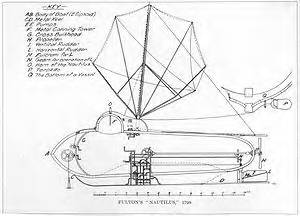
The Nautilus (1800) |
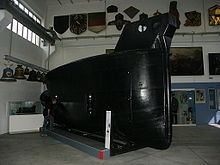
Brandtaucher in the Military History
Museum in Dresden |
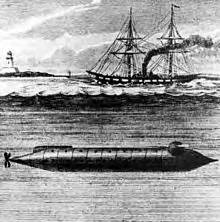
The French-designed 1862 Alligator,
first submarine of the U.S. Navy. |
Originally launched in 1864 as a human-powered
vessel, propelled by 16 men, it was converted to peroxide propulsion and
steam in 1867. The 14 meter (46 ft) craft was designed for a crew of two,
could dive to 30 metres (96 ft), and demonstrated dives of two hours. On
the surface it ran on a steam engine, but underwater such an engine would
quickly consume the submarine's oxygen; so Monturiol invented an air-independent
propulsion system. As the air-independent power system drove the screw,
the chemical process driving it also released oxygen into the hull for
the crew and an auxiliary steam engine. Apart from being mechanically powered,
Monturiol's pioneering double hulled vessels also solved pressure, buoyancy,
stability, diving and ascending problems that had bedeviled earlier designs.
In 1870, French writer Jules Verne published the
science fiction classic Twenty Thousand Leagues Under the Sea, which concerns
the adventures of a maverick inventor in Nautilus, a submarine more advanced
than any that existed at that time. The story inspired inventors to build
more advanced submarines.
In 1878 a Manchester curate, the Reverend George
Garrett obtained a patent for "Improvements in and appertaining to Submarine
or Subaqueous Boats" and set up a company to build them. His first prototype
Resurgam was hand powered and next year the company built the steam-powered
Resurgam II at Birkenhead. Garrett intended to demonstrate the 12 m long
vehicle to the Royal Navy at Portsmouth, but had mechanical problems, and
while under tow the submarine was swamped and sank off North Wales.
The first submarine built in series, however,
was human-powered. It was the submarine of the Polish inventor Stefan Drzewiecki
- 50 units were built in 1881 for the Russian government. In 1884 the same
inventor built an electric-powered submarine.
Discussions between George Garrett and Swede Thorsten
Nordenfelt led to a series of steam powered submarines. The first was the
Nordenfelt I, a 62 ton, 64 foot long spindle shaped vessel similar to the
Resurgam II, with a range of 150 miles and armed with a single external
torpedo, completed in 1885. Greece, fearful of the return of the Ottomans,
purchased it (the submarine was shipped in parts and assembled by the Ifaistos
machine works in Piraeus). Due to problems during testing, it was never
operationally utilized. Nordenfelt then built at Chertsey the Nordenfelt
II (Abdülhamid) in 1886 and Nordenfelt III (Abdülmecid) in 1887,
a pair of 98 foot long submarines with twin torpedo tubes, for the Ottoman
navy. The Abdülhamid achieved fame as the world's first submarine
to fire a torpedo underwater. Nordenfelt's efforts culminated in 1887 with
the Nordenfelt IV, with twin motors and twin torpedoes, built at Barrow-in-Furness.
It was sold to the Russians, but proved unstable, ran aground and was scrapped.
The first fully capable military submarine was
the electrically powered vessel built by the Spanish engineer and sailor,
Isaac Peral, for the Spanish Navy. It was launched on September 8, 1888.
It had two torpedoes, new air systems, hull shape and propeller and cruciform
external controls anticipating later designs. Its underwater speed was
ten knots. When fully charged it was the fastest submarine yet built, with
performance levels (except for range) that matched or exceeded those of
First World War U-boats. In June 1890 Peral's submarine launched a torpedo
under the sea. It was also the first submarine to incorporate a fully reliable
underwater navigation system. However, conservatives in the naval hierarchy
terminated the project despite two years of successful tests.
Also marking an important milestone in the development
of military submarines was the French navy's Gymnote, launched on September
24, 1888. The electrically powered Gymnote was another fully functional
military submarine. It completed 2,000 dives successfully. However, like
the Peral, its range was also limited by its reliance on batteries.
Many more submarines were built at this time by
various inventors, such as Simon Lake and Oliver Halstead, but they were
not to become effective weapons until the 20th century.
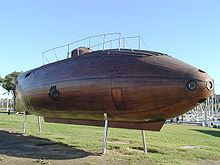
A replica of Monturiol's wooden
Ictineo II stands near Barcelona harbor. |
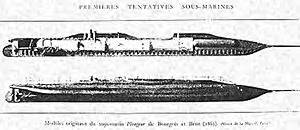
Plongeur, the first submarine that
did not rely on human power for propulsion. |

The Peral submarine in 1888 Its
hull can be seen today at Cartagena. |
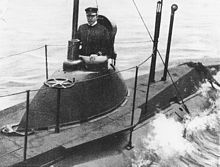
USS Plunger, launched in 1902 |
Late 19th century to the Russo-Japanese War
The turn of century era marked a pivotal time
in the development of submarines, with a number of important technologies
making their debut, as well as the widespread adoption and fielding of
submarines by a number of nations. Diesel Electric propulsion would become
the dominant power system and instruments such as the periscope would become
standardized. Large numbers of experiments were done by countries on effective
tactics and weapons for submarines, all of which would culminate in them
making a large impact on 20th century warfare.
The Irish inventor John Philip Holland built a
model submarine in 1876 and a full scale one in 1878, followed by a number
of unsuccessful ones. In 1896 he designed his Holland Type VI submarine,
that, for the first time, made use of internal combustion engine power
on the surface and electric battery power for submerged operations. Launched
on 17 May 1897 at Navy Lt. Lewis Nixon's Crescent Shipyard in Elizabeth,
New Jersey, the Holland VI was (eventually) purchased by the United States
Navy on 11 April 1900, becoming the United States Navy's first commissioned
submarine and renamed USS Holland. A prototype version of the A-class submarine
(Fulton) was developed (soon after) at Crescent under the supervision of
naval architect Arthur Leopold Busch for the newly reorganized Electric
Boat Company in 1900. The Fulton was never commissioned by the United States
Navy and was sold to the Imperial Russian Navy in 1905. Many countries
became interested in Holland's (weapons) product and purchased "the rights"
to build them during this time period. The Holland Torpedo Boat Company/Electric
Boat Company became General Dynamics "Cold War" progeny and is arguably
the builder of the world's most technologically advanced submarines to
this day.
The construction of the A-class boats soon followed
the prototype (Fulton). The submarines were built at two different shipyards
on both coasts of the United States. See: Union Iron Works/Mare Island
Naval Shipyard and Crescent Shipyard. In 1902, Holland received U.S. Patent
708,553 for his relentless pursuit to perfect the modern submarine craft.
Some of his vessels were purchased by the United States and other "technologically
advanced" nations such as the United Kingdom, the Imperial Russian Navy,
the Royal Netherlands Navy and the Imperial Japanese Navy. Mr. Holland
was no longer in control of his company at this point—as others were formally
engaged in transactions with many other foreign nations around the world
at this time. The Type VII design was also adopted by the Royal Navy as
well (with Holland's input, as the Holland class submarine, including Britain's
Holland #1).
Submarines in the Russo-Japanese War 1904-1905
Imperial Japanese Navy Submarines 1904-1905
On 14 June 1904 the Imperial Japanese Navy (IJN)
placed an order for five Holland Type VII submersibles, which were built
in Quincy, Massachusetts at the Fore River Yard, and shipped to Yokohama,
Japan in sections; all five machines arrived on 12 December 1904. Under
the supervision of naval architect Arthur L. Busch, the imported Hollands
were re-assembled, and the first submersibles were ready for combat operations
by August 1905, however hostilities were nearing the end by that date,
and no submarines saw action during the war.
In 1904 Kawasaki purchased rights from Holland
to manufacture two modified submersibles at Kobe, Japan. The two Kaigun
Hollands were numbered 6 & 7, and were both launched on 28 September,
but a year apart, in 1905 and 1906 respectively. The #6 & #7 "Kawasaki"
Hollands displaced 63/95 submerged tons, and measured 73'/84' in over all
length, respectively; each vessel measured approximately 7' in width (beam).
The two submarines had attained nearly a 50% increase in horsepower and
a 25% decrease in fuel consumption over the five imported Hollands, which
displaced over a 100 submerged tons each, and measured 67' in over all
length, and were 11' wide (beam). However, the two Kawasaki machines could
only launch one 18" torpedo and required 14 crewmen to operate, whilst
the imported Hollands could fire two 18" torpedoes and only needed 13 men
to operate. Kaigun Holland #6, the first submarine built in Japan, was
removed from the naval list in 1920 and preserved as a memorial in Kure,
Japan.
Imperial Russian Navy Submarines 1904–1905
The Imperial Russian Navy (IRN) preferred the
German constructed submersibles built by the Germaniawerft shipyards out
of Kiel. In 1903 Germany successfully completed its first fully functional
engine-powered submarine, Forelle (Trout). This vessel was sold to Russia
in 1904 and shipped via the Trans-Siberian Railway to the combat zone during
the Russo-Japanese War.
Due to the naval blockade of Port Arthur, Russia
sent their remaining submarines to Vladivostok, and by the end of 1904
seven subs were based there. On 1 January 1905, the IRN created the world's
first operational submarine fleet around these seven submarines. The first
combat patrol sent out by the newly created IRN submarine fleet occurred
on 14 February 1905 and was carried out by Delfin and Som, with each patrol
normally lasting about 24 hours. Som had her first enemy contact on 29
April, when she was fired upon by IJN torpedo boats, which withdrew shortly
after opening fire; resulting in no casualties or damage to either combatant.
A second contact occurred on 1 July 1905 in the Tartar Strait when the
IRN sub Keta was spotted by two IJN torpedo boats. Unable to submerge quick
enough, she was unable to obtain a proper firing position, and both combatants
broke contact.
In 1904, the IRN ordered several more submersibles
from the Keil shipyard, the Karp class. One example was modified and improved,
then commissioned into the Imperial German Navy in 1906 as its first U-boat,
U-1. In 1919, U-1 was retired and is currently preserved and on display
in the Deutsches Museum in Munich.
Submarines during World War I
The first time military submarines had significant
impact on a war was in World War I. Forces such as the U-boats of Germany
saw action in the war on Allied commerce (Handelskrieg). The submarine's
ability to function as a practical war machine relied on new tactics, their
numbers, and submarine technologies such as combination diesel/electric
power system that had been developed in the preceding years. More like
submersible ships than the submarines of today, Submarines operated primarily
on the surface using standard engines, submerging occasionally to attack
under battery power. They were roughly triangular in cross-section, with
a distinct keel, to control rolling while surfaced, and a distinct bow.
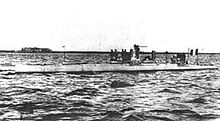
The 1900 French submarine Narval |

German submarine U9 (1910). She
sank three British cruisers in a few minutes in September 1914. |
Germany
At the start of the war Germany had 48 submarines
in service or under construction, of which 29 were operational. Initially
Germany followed the international "Prize Rules", which required a ship's
crew to be allowed to leave before sinking their ship. After the British
ordered transport ships to act as auxiliary cruisers, the German navy adopted
unrestricted submarine warfare;[citation needed] generally no warning was
given before an attack was made. During the war 360 submarines were built
but 178 were lost, and all the rest were surrendered at the end.
Ottoman Empire
Ottomans had seven submarines, of which only two
were serviceable.
Britain
There were 77 operational submarines at the beginning
of the war, with 15 under construction. The main type was the "E class",
but several experimental designs were built, including the "K class", which
had a reputation for bad luck, and the "M class", which had a large deck-mounted
gun. The "R class" was the first boat designed to attack other submarines.
British submarines operated in the Baltic, North Sea and Atlantic, as well
as in the Mediterranean and Black Sea. Over 50 were lost from various causes
during the war.
France
France had 62 submarines at the beginning of the
war, in 14 different classes. They operated mainly in the Mediterranean,
and in the course of the war, 12 were lost.
Russia
The Russians started the war with 58 submarines
in service or under construction. The main class was the "Bars" with 24
boats. Twenty-four submarines were lost during the war.
Interwar developments
Various new submarine designs were developed during
the interwar years. Among the most notorious ones were submarine aircraft
carriers, equipped with waterproof hangar and steam catapult and which
could launch and recover one or more small seaplanes. The submarine and
her plane could then act as a reconnaissance unit ahead of the fleet, an
essential role at a time when radar still did not exist. The first example
was the British HMS M2, followed by the French Surcouf, and numerous aircraft-carrying
submarines in the Imperial Japanese Navy. The 1929 Surcouf was also designed
as an "underwater cruiser," intended to seek and engage in surface combat.
Although Germany had been banned from having submarines,
construction started in secret during the 1930s. When this became known
the Anglo-German Treaty of 1936 allowed Germany to achieve parity in submarines
with Britain.
Submarines during World War II
Germany
Germany started the war with only 65 submarines,
with 21 at sea when war broke out. However Germany soon built up the largest
submarine fleet during World War II. Due to the Treaty of Versailles limiting
the surface navy, the rebuilding of the German surface forces had only
begun in earnest a year before the outbreak of World War II. Having no
hope of defeating the vastly superior Royal Navy decisively in a surface
battle, the German High Command planned on fighting a campaign of "Guerre
de course" (Merchant warfare), and immediately stopped all construction
on capital surface ships, save the nearly completed Bismarck-class battleships
and two cruisers, and switched the resources to submarines, which could
be built more quickly. Though it took most of 1940 to expand the production
facilities and get the mass production started, more than a thousand submarines
were built by the end of the war.
Germany put submarines to devastating effect in
World War II during the Battle of the Atlantic, attempting but ultimately
failing to cut off Britain's supply routes by sinking more ships than Britain
could replace. The supply lines were vital to Britain for food and industry,
as well as armaments from the United States. Although the U-boats had been
updated in the intervening years, the major innovation was improved communications,
encrypted using the famous Enigma cipher machine. This allowed for mass-attack
tactics or "wolfpacks" (Rudel), but was also ultimately the U-boats' downfall.
After putting to sea, the U-boats operated mostly
on their own trying to find convoys in areas assigned to them by the High
Command. If a convoy was found, the submarine did not attack immediately,
but shadowed the convoy and radioed to the German Command to allow other
submarines in the area to find the convoy. These were then grouped into
a larger striking force and attacked the convoy simultaneously, preferably
at night while surfaced to avoid the ASDIC.
In the first half of the War the submarines scored
spectacular successes with these tactics, but were too few to have any
decisive success. The attacks were made in the "Black Gap" between convoy
escort areas and, when this was closed, off the coast of America. In the
second half Germany had enough submarines, but this was more than nullified
by equally increased numbers of convoy escorts, aircraft, and technical
advances like radar and sonar. Huff-Duff and Ultra allowed the Allies to
route convoys around wolf packs when they detected them from their radio
transmissions.
Winston Churchill wrote that the U-boat threat
was the only thing that ever gave him cause to doubt the Allies' eventual
victory.
The Germans built some novel submarine designs,
including the Type XVII, which used hydrogen peroxide in a Walther turbine
(named for its designer, Dr Helmuth Walther) for propulsion. They also
produced the Type XXII, which had a large battery and mechanical torpedo
handling.
Italy
Italy had 116 submarines in service at the start
of the war, with 24 different classes. They operated mainly in the Mediterranean
but some were sent to a base at Bordeaux. A flotilla of several submarines
operated out of the Eritrean colonial port of Massawa. The Italian design
proved to be not very suitable for use in the Atlantic. The most interesting
use of Italian boats was of midget submarines in attacks against shipping
in the harbour at Gibraltar.
Japan
Japan had by far the most varied fleet of submarines
of World War II, including manned torpedoes (Kaiten), midget submarines
(Ko-hyoteki, Kairyu), medium-range submarines, purpose-built supply submarines
(many for use by the Army), long-range fleet submarines (many of which
carried an aircraft), submarines with the highest submerged speeds of the
conflict (Sentaka I-200), and submarines that could carry multiple aircraft
(WWII's largest submarine, the Sentoku I-400). These submarines were also
equipped with the most advanced torpedo of the conflict, the oxygen-propelled
Type 95 (what U.S. historian Samuel E. Morison postwar called "Long Lance").
Overall, despite their technical prowess, Japanese
submarines, having been incorporated into the Imperial Navy's war plan
of "Guerre D' Escadre" (Fleet Warfare), in contrast to Germany's war plan
of "Guerre De Course", they were relatively unsuccessful. Being primarily
used in the offensive roles against warships, which were fast, maneuverable
and well-defended compared to merchant ships. In 1942, Japanese submarines
sank two fleet aircraft carriers, one cruiser, and several destroyers and
other warships, and damaged many others, including two battleships. They
were not able to sustain these results afterward, as Allied fleets were
reinforced and became better organized. By the end of the war, submarines
were instead often used to transport supplies to island garrisons. During
the war, Japan managed to sink about 1 million tons of merchant shipping
(184 ships), compared to 1.5 million tons for Great Britain (493 ships),
4.65 million tons for the U.S. (1,079 ships) and 14.3 million tons for
Germany (2,840 ships).
Early models were not very maneuverable under
water, could not dive very deep, and lacked radar. (Later in the war units
that were fitted with radar were in some instances sunk due to the ability
of U.S. radar sets to detect their emissions. For example, Batfish (SS-310)
sank three such equipped submarines in the span of four days). After the
end of the conflict, several of Japan's most original submarines were sent
to Hawaii for inspection in "Operation Road's End" (I-400, I-401, I-201
and I-203) before being scuttled by the U.S. Navy in 1946, when the Soviets
demanded access to the submarines as well.
France
France had 112 submarine in service at the beginning
of the war. They operated in the North Sea and off Norway. After the French-German
Armistice, French submarines were required to return to France but many
were commandeered by the British. The German capture of French submarine
bases gave them freer access to the Atlantic.
Britain
There were 70 operational submarines in 1939.
Two classes were selected for mass production, the seagoing "S class" and
the ocean going "T class" as well as the coastal "U class". All were built
in large numbers during the war. They operated off Norway during the German
invasion as well as in the North Sea. In the Mediterranean they attacked
Axis supplies to North Africa from their base in Malta. In addition British
submarines attacked Japanese shipping in coastal waters during the Pacific
campaign.
Soviet Union
The Red Fleet had 144 submarines in service or
under construction at the start of the war.
United States
The U.S. used its submarines to attack merchant
shipping (commerce raiding or guerre de course), in an effort to starve
both Japanese Pacific island forces and the home islands, and to prevent
imports of raw materials and oil.
Where Japan had the finest submarine torpedoes
of the war, the USN had perhaps the worst, the Mark 14 steam torpedo, with
a Mk 6 magnetic influence exploder designed to explode under the hull of
the target vessel and a Mk 5 contact exploder, neither of which was reliable.
For the first twenty months of the war, senior Submarine Force commanders
(including RADM Ralph Christie, ComSouthWestPac, a key member of the Mk
6's design team) attributed the torpedo failures to poor approach and attack
techniques by submarine commanders. The depth control mechanism of the
Mark 14 (designed for an earlier slower-running torpedo) was corrected
in August 1942, but field trials for the exploders were not even ordered
until mid-1943, when tests in Hawaii and Australia confirmed the flaws.
The Mk 6 exploder was corrected by deactivating
its magnetic influence mechanism and changing the firing pin of the contact
exploder from one of high-friction steel to a less-friction alloy. The
modifications were retro-fitted on torpedoes in service and incorporated
into new production, after which the Mark 14 became a reliable weapon.
In September 1943 the Mark 18 electric torpedo
was placed into service to provide a "wakeless" torpedo, but its range
and speed were less than that of the Mark 14 and it had a smaller warhead.
It too showed flaws that had not been corrected by testing: its battery
produced hydrogen gas that could not be vented and it showed a disturbing
tendency to "run circular" (that is, to travel in a circular path back
to the firing submarine). The losses of the USS Tang and the USS Tullibee
in 1944 resulted from self-inflicted hits by Mark 18 torpedoes fired from
their stern tubes (which hit the submarines amidships), and the USS Wahoo
may have been severely crippled by a circular hit on her bow before being
bombed by aircraft.
During World War II 314 submarines served in the
United States Navy. 111 boats were in commission on 7 December 1941, with
38 of these considered modern "fleet boats", and of that number, 23 were
lost. 203 submarines from the Gato, Balao, and Tench classes were commissioned
during the war, with 29 lost. In total the United States Navy lost 52 boats
to all causes during hostilities, and 41 of the losses were directly attributable
to enemy action. 3,506 submariners were killed or missing-in-action.
At first, Japanese anti-submarine defenses proved
less than effective against U.S. submarines. Japanese sub-detection gear
was not as advanced as that of some other nations. The primary Japanese
anti-sub weapon for most of WWII was the depth charge. During the first
part of the war, the Japanese tended to set their depth charges too shallow,
and U.S. subs not trapped in shallow waters were frequently able to take
advantage of depth gradient temperatures to escape from many attacks.
Historian Clay Blair claimed that Congressman
Andrew J. May at a press conference held in June 1943 revealed the highly
sensitive fact that American submarines had a high survival rate because
Japanese depth charges were typically fuzed to explode at too shallow a
depth. Various press associations sent this leaked news story over their
wires and many newspapers (including one in Honolulu, Hawaii), published
it.
Japanese naval forces heard of May's security
breach and adjusted their depth charges to explode at a more effective
depth. Vice Admiral Charles A. Lockwood, commander of the U.S. submarine
fleet in the Pacific, later estimated that May's security breach cost the
United States Navy as many as ten submarines and 800 crewmen killed in
action.
Other historians claim that the May Incident never
happened, and that the Japanese never discovered U.S. submarine depth capabilities
during the war.
In addition to resetting their depth charges to
deeper depths, Japanese anti-submarine forces also began employing auto-gyro
aircraft and MAD (magnetic anomaly detection) equipment to sink U.S. subs,
particularly those plying major shipping channels or operating near the
home islands. Despite this onslaught, U.S. sub sinkings of Japanese shipping
continue to increase at a furious rate as more U.S. subs deployed each
month to the Pacific. By the end of the war, U.S. submarines had destroyed
more Japanese shipping than all other weapons combined, including aircraft.
Operationally, two commands in the Pacific Theater,
Submarines Pacific and Submarines Southwest Pacific, conducted 1,588 war
patrols, resulting in the firing of 14,748 torpedoes and the sinking of
1,392 enemy vessels of a total tonnage of 5.3 million tons. Over 200 warships
were sunk, including a battleship, 8 aircraft carriers of varying sizes,
11 cruisers, 38 destroyers, 25 submarines (including 2 U-Boats), and 70
other escort vessels. Submarines Pacific was assigned 51 boats in 1941;
by the end of the war 169 boats were assigned. Monthly war patrols averaged
27 in 1942 and increased to 47 in 1945, with a high of 57 patrols dispatched
in May 1945.
Post-War submarines
The first launch of a cruise missile (SSM-N-8
Regulus) from a submarine occurred in July 1953 from the deck of USS Tunny
(SSG-282), a World War II fleet boat modified to carry this missile with
a nuclear warhead. Tunny and her sister boat USS Barbero (SSG-317) were
the United States's first nuclear deterrent patrol submarines. They were
joined in 1958 by two purpose built Regulus submarines, USS Grayback (SSG-574),
USS Growler (SSG-577), and, later, by the nuclear-powered USS Halibut (SSGN-587).
So that no target would be left uncovered, four Regulus missiles had to
be at sea at any given time. Thus, Barbero and Tunny, each of which carried
two Regulus missiles, patrolled simultaneously. Growler and Grayback, with
four missiles, or Halibut, with five, could patrol alone. These five submarines
made 40 Regulus strategic deterrent patrols between October 1959 and July
1964.
In the 1950s, nuclear power partially replaced
diesel-electric propulsion. The sailing of the first nuclear-powered submarine,
the USN "Nautilus" in 1955 was soon followed by similar British, French
and Russian boats. Equipment was also developed to extract oxygen from
sea water. These two innovations, together with inertial navigation systems,
gave submarines the ability to remain submerged for weeks or months, and
enabled previously impossible voyages such as the crossing of the North
Pole beneath the Arctic ice cap by the USS Nautilus in 1958. Most of the
naval submarines built since that time in the United States and the Soviet
Union and its successor state the Russian Federation have been powered
by nuclear reactors. The limiting factors in submerged endurance for these
vessels are food supply and crew morale in the space-limited submarine.
While the greater endurance and performance from
nuclear reactors mean that nuclear submarines are better for long distance
missions or the protection of a carrier battle-force, conventional diesel-electric
submarines have continued to be produced by both nuclear and non-nuclear
powers, as they can be made stealthier, except when required to run the
diesel engine to recharge the ship's battery. Technological advances in
sound dampening, noise isolation and cancellation have substantially eroded
this advantage. Though far less capable regarding speed and weapons payload,
conventional submarines are also cheaper to build. The introduction of
air-independent propulsion boats led to increased sales numbers of such
types of submarines.
In 1958 the USN carried out a series of trials
with the USS Albacore. Various hull and control configurations were tested
to reduce drag and so allow greater underwater speed and maneuverability.
The results of these trials were incorporated into the Skipjack class and
later submarines. From the same era is the first SSBN, the USS George Washington.
During the Cold War, the United States and the
Soviet Union maintained large submarine fleets that engaged in cat-and-mouse
games; this continues today, on a much-reduced scale. The Soviet Union
suffered the loss of at least four submarines during this period: K-129
was lost in 1968 (which the CIA attempted to retrieve from the ocean floor
with the Howard Hughes-designed ship named Glomar Explorer), K-8 in 1970,
K -219 in 1986 (subject of the film Hostile Waters), and Komsomolets (the
only Mike class submarine) in 1989 (which held a depth record among the
military submarines -1000 m, or 1300 m according to the article K-278).
Many other Soviet subs, such as K-19 (first Soviet nuclear submarine, and
first Soviet sub at North Pole) were badly damaged by fire or radiation
leaks. The United States lost two nuclear submarines during this time:
USS Thresher and Scorpion. The Thresher was lost due to equipment failure,
and the exact cause of the loss of the Scorpion is not known.
The sinking of PNS Ghazi in the Indo-Pakistani
War of 1971 was the first submarine casualty in the South Asian region.
The United Kingdom employed nuclear-powered submarines
against Argentina during the 1982 Falklands War; the sinking of the cruiser
ARA General Belgrano by HMS Conqueror was the first sinking by a nuclear-powered
submarine in war. During this conflict the conventional Argentinian submarine
ARA Santa Fé was disabled by a Sea Skua missile, and the ARA San
Luis claimed to have made unsuccessful attacks on the British fleet.
Polar operations
1903 - Simon Lake's submarine Protector surfaced
through ice off Newport, Rhode Island.
1931 - Nautilus (ex. USS O-12) operated under
ice near Spitsbergen.
1937 - Soviet submarine Krasnogvardeyets operated
under ice in the Denmark Strait.
1941-45 - German U-boats operated under ice from
the Barents Sea to the Laptev Sea.
1946 - USS Atule used upward-beamed fathometer
in Operation Nanook in the Davis Strait.
1946-47 - USS Sennet used under-ice SONAR in
Operation High Jump in the Antarctic.
1947 - USS Boarfish used upward-beamed echo sounder
under pack ice in the Chukchi Sea.
1948 - USS Carp developed techniques for making
vertical ascents and descents through polynyas in the Chukchi Sea.
1952 - USS Redfish used an expanded upward-beamed
sounder array in the Beaufort Sea.
1957 - USS Nautilus reached 87 degrees north
near Spitsbergen.
3 August 1958 - Nautilus used an inertial navigation
system to reach the north pole.
17 March 1959 - USS Skate surfaced through the
ice at the north pole.
1960 - USS Sargo transited 900 miles under ice
over the shallow (125 to 180 feet deep) Bering-Chukchi shelf.
1960 - USS Seadragon transited the Northwest
Passage under ice.
1962 - Soviet November-class submarine Leninskiy
Komsomol reached the north pole.
1971 - HMS Dreadnought reached the north pole.
6 May 1986 - USS Ray, USS Hawkbill, and USS Archerfish,
as part of LANTSUBICEX '86, surfaced together at the North Pole. First
multi-submarine surfacing in history.
19 May 1987 - HMS Superb joined USS Billfish
and USS Sea Devil at the North Pole. The first time British and Americans
met at the North Pole.
March 2007 - USS Alexandria participated in the
Joint U.S. Navy/Royal Navy Ice Exercise 2007 (ICEX-2007) in the Arctic
Ocean with the Trafalgar-class submarine HMS Tireless. |
Ballistic missile submarines
Ballistic missile submarines (SSBNs or boomers
in American slang) carry submarine-launched ballistic missiles (SLBM) with
nuclear warheads, for attacking strategic targets such as cities or missile
silos anywhere in the world. They are currently universally nuclear-powered,
to provide the greatest stealth and endurance. (The first Soviet ballistic
missile submarines were diesel-powered.) They played an important part
in Cold War mutual deterrence, as both the United States and the Soviet
Union had the credible ability to conduct a retaliatory strike against
the other nation in the event of a first strike. This comprised an important
part of the strategy of Mutual Assured Destruction.
The US has 18 Ohio-class submarines, of which
14 are Trident II SSBNs, each carrying 24 SLBMs. The American George Washington
class "boomers" were named for famous Americans, and together with the
Ethan Allen, Lafayette, James Madison, and Benjamin Franklin classes, these
SSBNs comprised the Cold War-era "41 for Freedom." Later Ohio-class submarines
were named for states (recognizing the increase in striking power and importance,
equivalent to battleships), with the exception that SSBN-730 gained the
name of a Senator. The first four Ohio-class vessels were equipped with
Trident I, and have now been converted to carry Tomahawk guided missiles
for land and shipping attack.
For Russia, see List of NATO reporting names for
ballistic missile submarines.
The Royal Navy possess a single class of four
ballistic missile submarines (what RN call "bombers", for their function),
the Vanguard class with Trident missiles. The Royal Navy's previous ballistic
missile submarine class was the Resolution class, with Polaris missiles,
which also consisted of four boats. The Resolutions, named after battleships
to convey the fact they were the new capital ships, were decommissioned
when the Vanguards entered service in the 1990s.
France operates a force de frappe, including a
nuclear ballistic submarine fleet made up of one SSBN Redoutable class
and three SSBNs of the Triomphant class. One additional SSBN of the Triomphant
class is under construction.
The People's Republic of China's People's Liberation
Army Navy's SLBM inventory is relatively new. China launched its first
nuclear armed submarine in April 1981. The PLAN currently has 1 Xia class
("Type 92") at roughly 8,000 tons displacement. The Type 92 is equipped
with 12 SLBM launching tubes. China's SLBM program is built around its
JL-1 inventory. The Chinese Navy is estimated to have 24 JL-1s. The JL-1
is basically a modified DF-21.
The PLAN plans to replace its JL-1 with an unspecified
number of the longer ranged, more modern JL-2s. Deployment on the JL-2
reportedly began in late 2003.
Attack submarines
Attack submarines are fast, long range boats with
torpedoes and cruise missiles to attack submarines, ships and land targets.
They carry sonars, and other sensors, for target location and fire control
systems for weapon launching.
In 1982 a study group was set up by the USN to
define the requirements for a new SSN, later known as Seawolf. The submarine
was commissioned in 1997. It had twice the weapon load of the Los Angeles
class, with a new combat system (BSY-2) and new sonars. Unfortunately its
cost proved unacceptable and so a more affordable design was started. This
Virginia class had a reduced weapon load but with a wide variety of types.
The Royal Navy is building the Astute-class submarines
as successors to its Swiftsure and Trafalgar classes. The first was launched
in 2007.
The latest Chinese attack submarine class is the
Type 093 (Shang), first launched in 2002, which is replacing the Type 091
(Han) class.
The Russian 949A (Oscar II) SSN was built from
about 1989 to the late 90s. Older attack submarines have been decommissioned.
In Australia six Collins-class SSKs were built
between 1996 and 2003, while Sweden has built three A19 SSKs.
The French Barracuda-class submarine is planned
but will not replace its Rubis attack submarines until 2016.
Modern civil submarines
Tourist Submarines
These boats are lead-acid battery powered, being
charged between runs from support facilities. They may have a surface speed
of a few knots but generally their underwater speed is less than a knot.
Their depth capabilities are often only a few metres. Some are capable
of carrying over 50 passengers. They are found in the major tourist resorts
in the warm water regions.
Private submarines
These can be used for a variety of purposes from
scientific research, underwater filming and construction to search and
salvage. They often can be fitted with a number of tools with lights, cameras,
acoustic tracking and communications. They tend to be 2 or 3 person craft,
sometimes with diver lockout facilities. Alternatively they can be simple
craft used to aid divers.
Human powered submarines
Races are held in the David Taylor Model Basin
in the U.S. over a 100 m course. The 9th races were held in 2007 at which
22 teams took part, with 26 submarines. A speed record of 8 knots was set
for a two man submarine and 5 knots for a one man submarine.
Major submarine incidents
Early incidents
Up to August 1914 there were 68 submarine accidents.
There were 23 collisions, 7 battery gas explosions, 12 gasoline explosions,
and 13 sinkings due to hull openings not being closed.
Cold War incidents
There have been a number of accidental sinkings
but also some collisions between submarines. Examples of the former include
the loss of HMS Affray in the English Channel in 1951 due to the snort
mast fracturing, USS Thresher in 1963 due to a pipe weld failure during
a test dive, however many other scenarios have been proven to be probable
causes of sinking, most notably a battery malfunction causing a torpedo
to detonate internally, and the loss of the Russian Kursk on 12 August
2000 probably due to a torpedo explosion. An example of the latter was
the incident between the Russian K-276 and the USS Baton Rouge in February
1992.
Incidents since 2000
Since submarines have been actively deployed,
there have been several incidents involving submarines that were not part
of major combat. Most of these incidents were during the Cold War, but
some are more recent. Since the year 2000 there have been 9 major naval
incidents involving submarines. There were three Russian submarine incidents,
in two of which the submarines in question were lost, along with three
United States submarine incidents, one Chinese incident, one Canadian,
and one Australian incident. In August 2005, the Russian PRIZ, an AS-28
rescue submarine was trapped by cables and/or nets off of Petropavlovsk,
and saved when a British ROV cut them free in a massive international effort.
History of submarine technology
Propulsion
Until the advent of nuclear marine propulsion,
most 20th-century submarines used batteries for running underwater and
gasoline (petrol) or diesel engines on the surface and to recharge the
batteries. Early boats used gasoline but this quickly gave way to kerosene,
then diesel, because of reduced flammability. Diesel-electric became the
standard means of propulsion. Initially the diesel or gasoline engine and
the electric motor were on the same shaft, which also drove a propeller
with clutches between each of them. This allowed the engine to drive the
electric motor as a generator to recharge the batteries and also propel
the submarine if required. The clutch between the motor and the engine
would be disengaged when the boat dived so that the motor could be used
to turn the propeller. The motor could have more than one armature on the
shaft-these would be electrically coupled in series for slow speed and
parallel for high speed (known as "group down" and "group up" respectively).
In the 1930s the principle was modified for some
submarine designs, particularly those of the U.S. Navy and the British
U-class. The engine was no longer attached to the motor/propeller drive
shaft but drove a separate generator, which would drive the motors on the
surface and/or recharge the batteries. This diesel-electric propulsion
allowed much more flexibility, for example the submarine could travel slowly
whilst the engines were running at full power to recharge the batteries
as quickly as possible, reducing time on the surface, or use its snorkel.
Also it was now possible to insulate the noisy diesel engines from the
pressure hull making the submarine quieter.
There were other power sources attempted—oil-fired
steam turbines powered the British "K" class submarines built during the
First World War and in following years but these were not very successful.
This was selected to give them the necessary surface speed to keep up with
the British battle fleet.
Steam power was resurrected in the 1950s with
the advent of the nuclear-powered steam turbine driving a generator, which
is now used in all large submarines. There was an attempt to use a very
advanced lead cooled fast reactor on Project 705 "Lira" but it's maintenance
was considered too expensive. By removing the requirement for atmospheric
oxygen these submarines can stay submerged indefinitely so long as food
supplies remain (air is recycled and fresh water distilled from seawater).
These vessels always have a small battery and diesel engine/generator installation
for emergency use when the reactors have to be shut down.
Anaerobic propulsion was employed by the first
mechanically driven submarine Ictineo II in 1864. Ictineo's engine used
a chemical mix containing a peroxide compound, that generated heat for
steam propulsion while at the same time solved the problem of oxygen renovation
in an hermetic container for breathing purposes. The system wasn't employed
again until 1940 when the German Navy tested a system employing the same
principles, the Walter turbine, on the experimental V-80 submarine and
later on the naval U-791 submarine. At the end of the Second World War
the British and Russians experimented with hydrogen peroxide/kerosene (paraffin)
engines, which could be used both above and below the surface. The results
were not encouraging enough for this technique to be adopted at the time,
although the Russians deployed a class of submarines with this engine type
code named Quebec by NATO, they were considered a failure. Today several
navies, notably Sweden now use air-independent propulsion boats, which
substitute liquid oxygen for hydrogen peroxide.
The German Type 212 submarine uses nine 34-kilowatt
hydrogen fuel cell as air-independent propulsion, which makes it first
series production submarine using fuel cell.
Most small modern commercial submarines that are
not expected to operate independently use batteries that can be recharged
by a mother-ship after every dive.
Towards the end of the 20th century, some submarines
began to be fitted with pump-jet propulsors instead of propellers. Although
these are heavier, more expensive, and often less efficient than a propeller,
they are significantly quieter, giving an important tactical advantage.
A possible propulsion system for submarines is
the magnetohydrodynamic drive, or "caterpillar drive", which has no moving
parts. It was popularized in the movie version of The Hunt for Red October,
written by Tom Clancy, which portrayed it as a virtually silent system.
(In the book, a form of propulsor was used rather than an MHD.) Although
some experimental surface ships have been built with this propulsion system,
speeds have not been as high as those hoped. In addition, the noise created
by bubbles, and the higher power settings a submarine's reactor would need,
mean that it is unlikely to be considered for any military purpose.
The schnorchel
Drebbel's 1620 submarine is thought to have incorporated
floats with tubes to allow air down to the rowers. The steam powered submarines
used to run with their hulls awash with air being taken down through their
conning towers. During the First World War the British are believed to
have experimented with a similar concept to the schnorkel, that is a mast
through which air is drawn.
Diesel submarines needed air to run their engines,
and so carried very large batteries for submerged travel. These limited
the speed and range of the submarines while submerged. The schnorchel (used
by prewar Dutch submarines) was used after 1943 to allow German submarines
to run just under the surface, attempting to avoid detection visually and
by radar. After the war the concept became widely used and the term was
anglicised to "shnorkel" or "snorkel" in English. The German navy also
experimented with engines that would use hydrogen peroxide to allow diesel
fuel to be used while submerged, but technical difficulties were great.
Sensors
Originally submarines were navigated using a porthole
but the periscope was introduced by World War I. Passive sonar was introduced
in submarines during the First World War but active sonar ASDIC did not
come into service until the inter-war period. Today the submarine may have
a wide variety of sonar arrays, from bow mounted to trailing ones. There
are often upward-looking under-ice sonars as well as depth sounders.
Radar came in during the 1930s, with radar warning
receivers in the Second World War.
Fire control
Originally the submarine's torpedoes were aimed
by pointing the boat in the correct direction. This was determined from
the targets course and speed by measurements of angle and range via the
periscope. The necessary calculation was first carried out manually and
later by mechanical calculators. Today it is achieved by digital computers
with display screens providing all necessary information on the torpedo
status and ship status.
Weapons and countermeasures
Early submarines carried torpedoes externally
and then internally. In the latter case both bow mounted and stern mounted
tubes were used but today only the former are still employed. Some specialised
mine laying submarines were built. The modern submarine is capable of firing
many types of weapon from its launch tubes, including UAVs.
Up until the end of WW2 it was common to fit deck
guns to submarines to allow them to sink ships without wasting torpedoes.
German submarines in World War II had rubber coatings
and could launch chemical devices to provide a decoy when the boat was
under attack. These proved to be not very effective as sonar operators
came to distinguish between the decoy and the submarine. Modern submarines
can launch a variety of devices for the same purpose, as well as having
coatings.
Communications
Wireless was used to provide communication to
and from submarines in the First World War. With time the type, range and
bandwidth of the communications systems have increased. Because of the
danger of intercept, transmissions by a submarine are minimised. Various
periscope mounted aerials have been developed to allow communication without
surfacing.
Navigation
The standard navigation system for early submarines
was by eye, with use of a compass. The gyrocompass was introduced in the
early part of the 20th century and inertial navigation in the 1950s. The
use of satellite based navigation is of limited use to submarines, except
at periscope depth or when surfaced.
Escape
After the sinking of the A1 submarine in 1904,
lifting eyes were fitted to British submarines and in 1908 air-locks and
escape helmets were provided. The RN experimented with various types of
escape apparatus but it was not until 1924 that the "Davis Submerged Escape
Apparatus" came in. The USN used the similar "Momsen Lung". The French
used "Joubert's apparatus" and the Germans used "Draeger's apparatus".
Rescue submarines for evacuating a disabled submarine's
crew came in the 1970s and the British unmanned vehicle was used for recovering
an entangled Russian submarine crew in 2005. A new NATO Submarine Rescue
System entered service in 2007. |